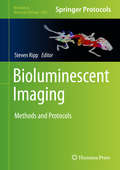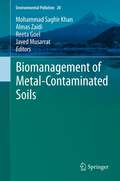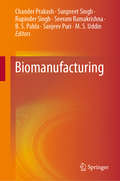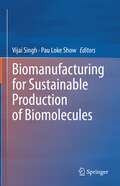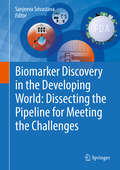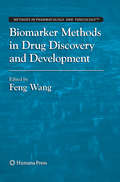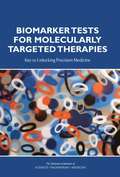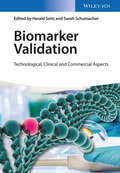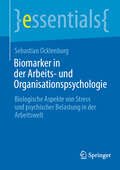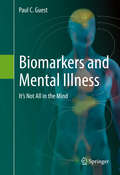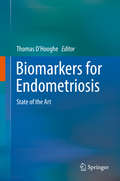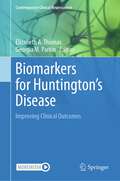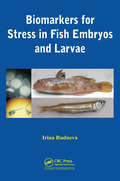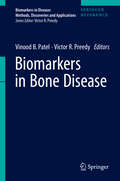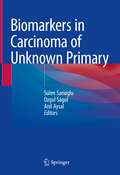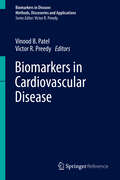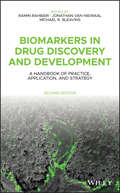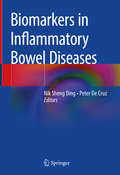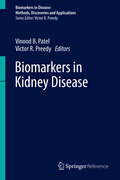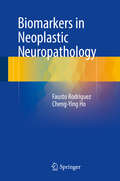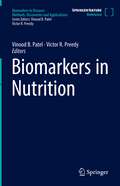- Table View
- List View
Bioluminescent Imaging: Methods and Protocols (Methods in Molecular Biology #2081)
by Steven RippThis volume provides detailed protocols and methodologies required to perform bioluminescent imaging in multiple stages, enabling the reader to integrate this technology into their laboratory-based imaging experiments. Written in the highly successful Methods in Molecular Biology series format, chapters include introductions to their respective topics, lists of the necessary materials and reagents, step-by-step, readily reproducible laboratory protocols, and tips on troubleshooting and avoiding known pitfalls. Authoritative and cutting-edge, Bioluminescent Imaging: Methods and Protocols to ensure successful results in the further study of this vital field.
Biomagnetics: Principles and Applications of Biomagnetic Stimulation and Imaging
by Trevor R. HodkinsonDiscover the Most Advanced Technologies in BiomagneticsCo-edited by Professor Ueno, a leader in the biomagnetics field for over 40 years, Biomagnetics: Principles and Applications of Biomagnetic Stimulation and Imaging explains the physical principles of biomagnetic stimulation and imaging and explores applications of the latest techniques in neuroscience, clinical medicine, and healthcare. The book shows you how the techniques are used in hospitals and why they are so promising. A brief overview of recent research trends in biomagnetics provides you with an up-to-date, informative guide to explore further in this field.The book focuses on three important areas: Magnetic nerve stimulation and transcranial magnetic stimulation Biomagnetic measurements and imaging of the human brain by advanced technologies of magnetoencephalography and MRI Biomagnetic approaches to potential treatments of cancers, pains, and other neurological and psychiatric diseases, such as Alzheimer’s disease and depression These core areas of the book were developed from the editors’ prestigious graduate-level courses in biomedical engineering. The text also discusses biomagnetic approaches to advanced medicine, including regenerative and rehabilitation medicine.
Biomanagement of Metal-Contaminated Soils (Environmental Pollution #20)
by Javed Musarrat Almas Zaidi Mohammad Saghir Khan Reeta GoelHeavy-metal contamination is one of the world's major environmental problems, posing significant risks to agro-ecosystems. Conventional technologies employed for heavy-metal remediation have often been expensive and disruptive. This book provides comprehensive, state-of-the-art coverage of the natural, sustainable alternatives that use a wide range of biological materials in the removal/detoxification of heavy metals, consequently leading to the improvement of crops in these soils. Novel, environmentally friendly and inexpensive solutions are presented based on a sound understanding of metal contamination and the roles of plants and microbes in the management of these toxic soils. Written by worldwide experts, the book provides not only the necessary scientific background but also addresses the challenging questions that require special attention in order to better understand metal toxicity in soils and its management through bioremediation.
Biomanufacturing
by Seeram Ramakrishna Rupinder Singh Chander Prakash Sunpreet Singh B. S. Pabla Sanjeev Puri M. S. UddinCurrent Trends in Biomanufacturing focuses on cutting-edge research regarding the design, fabrication, assembly, and measurement of bio-elements into structures, devices, and systems.The field of biomaterial and biomanufacturing is growing exponentially in order to meet the increasing demands of for artificial joints, organs and bone-fixation devices. Rapid advances in the biological sciences and engineering are leading to newer and viable resources, methods and techniques that may providing better quality of life and more affordable health care services.The book covers the broad aspects of biomanufacturing, including:synthesis of biomaterials;implant coating techniques;spark plasma sintering;microwave processing; andcladding, powder metallurgy and electrospinning.The contributors illustrate the recent trends of biomanufacturing, highlighting the important aspects of biomaterial synthesis, and their use as feedstock of fabrication technologies and their characterization, along with their clinical practices. Current Trends in Biomanufacturing updates researchers and scientists the novelties and techniques of the field, as it summarises numerous aspects of biomanufacturing, including synthesis of biomaterials, fabrication of biomedical structures, their in-vivo/ in-vitro, mechanical analysis and associated ISO standards.
Biomanufacturing for Sustainable Production of Biomolecules
by Pau Loke Show Vijai SinghThis book elucidates the sustainable production of commercially important biomolecules in medicines, food, and beverage processing, through biological systems, including microorganisms, animal cells, plant cells, tissues, enzymes, and in vitro. It discusses promising technologies for the manipulation of cells including, genetic engineering, synthetic biology, genome editing, and metabolic engineering. The initial chapters of the book introduce topics on biomanufacturing, circular economy, strain design and improvement, upstream and downstream processing. The subsequent chapters cover artificial intelligence-assisted production, designer cell factories, biosensors for monitoring biomolecules, different cells factories, biosynthetic pathways, and genome editing approaches for scale-up biomanufacturing. Lastly, the book discusses the opportunities and challenges of implementing biological systems for the production of biomolecules. This book is a valuable source for students, researchers, scientists, clinicians, stakeholders, policymakers, and practitioners to understand biomanufacturing for the sustainable production of biomolecules.
Biomarker Discovery in the Developing World: Dissecting the Pipeline for Meeting the Challenges
by Sanjeeva SrivastavaThis book is oriented towards post-graduates and researchers with interest in proteomics and its applications in clinical biomarker discovery pipeline. Biomarker discovery has long been the research focus of many life scientists globally. However, the pipeline starting from discovery to validation to regulation as a diagnostic or therapeutic molecule follows a complex trajectory. This book aims to provide an in-depth synopsis on each of these developmental phases attendant to biomarker "life cycle" with emphasis on the emerging and significant role of proteomics. The book begins with a perspective on the role of biorepositories and need for biobanking practices in the developing world. The next chapter focuses on disease heterogeneity in context to geographical bias towards susceptibility to the disease and the role of multi-omics techniques to devise disruptive innovations towards biomarker discovery. Chapter 3 focuses on various omics-based platforms that are currently being used for biomarker discovery, their principles and workflow. Mass spectrometry is emerging as a powerful technology for discovery based studies and targeted validation. Chapter 4 aims at providing a glimpse of the basic workflow and considerations in mass spectrometry based studies. Rapid and aptly targeted research funding has often been deemed as one of the decisive factors enabling excellent science and path breaking innovations. With the need for sophistication required in multi-omics research, Chapter 5 focuses on innovative funding strategies such as crowdfunding and Angel philanthropy. Chapter 6 provides the latest advances in education innovation, the premise and reality of bioeconomy especially in a specific context of the developing world, not to mention the new concept of "social innovation" to link biomarkers with socially responsible and sustainable applications. Chapter 7, in ways similar to biomarkers, discusses the biosimilars as a field that has received much focus and prominence recently due to their immense potential in clinical and pharmaceutical innovation literatures. The broader goal post-biomarker discovery is to translate their use in clinics. However, the road from bench-to-bed side is arduous and complex that is subject to oversight from various national and international regulatory bodies. Chapter 8 underscores these regulatory science considerations and provides a concise overview on intellectual property rights in biomarker discovery. Thus, this book contributed by eminent biomarker scientists, clinicians, translational researchers and social scientists holistically covers the various facets of the biomarker discovery journey from "cell to society" in developing world. The lessons learned and highlighted here are of interest to the life sciences community in a global and interdependent world.
Biomarker Methods in Drug Discovery and Development (Methods in Pharmacology and Toxicology)
by Feng WangIn this book, expert researchers provide a tool box for those who have a general interest in biomarker research and for those currently specializing in certain technologies but desiring an understanding of other available methodologies. Its chapters include validated, mature methods as well as new, incredibly promising protocols. This book is the perfect biomarker technical guideline and reference to stimulate more exciting biomarker research and technology development.
Biomarker Tests for Molecularly Targeted Therapies: Key to Unlocking Precision Medicine
by Engineering Medicine National Academies of SciencesEvery patient is unique, and the evolving field of precision medicine aims to ensure the delivery of the right treatment to the right patient at the right time. In an era of rapid advances in biomedicine and enhanced understanding of the genetic basis of disease, health care providers increasingly have access to advanced technologies that may identify molecular variations specific to an individual patient, which subsequently can be targeted for treatment. Known as biomarker tests for molecularly targeted therapies, these complex tests have the potential to enable the selection of the most beneficial treatment (and also to identify treatments that may be harmful or ineffective) for the molecular underpinnings of an individual patient’s disease. Such tests are key to unlocking the promise of precision medicine. Biomarker tests for molecularly targeted therapies represent a crucial area of focus for developing methods that could later be applicable to other areas of precision medicine. The appropriate regulatory oversight of these tests is required to ensure that they are accurate, reliable, properly validated, and appropriately implemented in clinical practice. Moreover, common evidentiary standards for assessing the beneficial impact of biomarker-guided therapy selection on patient outcomes, as well as the effective collection and sharing of information related to those outcomes, are urgently needed to better inform clinical decision making. Biomarker Tests of Molecularly Targeted Therapies examines opportunities for and challenges to the use of biomarker tests to select optimal therapy and offers recommendations to accelerate progress in this field. This report explores regulatory issues, reimbursement issues, and clinical practice issues related to the clinical development and use of biomarker tests for targeting therapies to patients. Properly validated, appropriately implemented biomarker tests hold the potential to enhance patient care and improve outcomes, and therefore addressing the challenges facing such tests is critical.
Biomarker Validation
by Sarah Schumacher Harald SeitzFrom the Contents: * Biomarkers - Past and Future * Quantitative Proteomics Techniques in Biomarker Discovery* Biomarker Qualification: A Company Point of View* Biomarker Discovery and Medical Diagnostic Imaging* Breath: An Often Overlooked Medium in Biomarker Discovery* HTA in Personalized Medicine Technologies* Bone Remodeling Biomarkers: New Actors on the Old Cardiovascular Stage* Identification and Validation of Breast Cancer Biomarkers* Evaluation of Proteomic Data: From Profiling to Network Analysis by Way of Biomarker Discovery* Biomarkers: From Discovery to Commercialization* Clinical Validation* Genomics and Proteomics for Biomarker Validation For Biochemists, Clinical Chemists, Oncologists, Laboratory Medics, and Analytical Research Institutes.
Biomarker in der Arbeits- und Organisationspsychologie: Biologische Aspekte von Stress und psychischer Belastung in der Arbeitswelt (essentials)
by Sebastian OcklenburgDieses essential gibt einen Überblick über Biomarker-Forschung in der Arbeits- und Organisationspsychologie. Dabei werden die zentralen Biomarker und Methoden zur Erfassung von Biomarkern erläutert. Der Autor beleuchtet spezifisch relevante Biomarker für psychische Erkrankungen im Kontext der Arbeitswelt sowie Biomarker für psychische Belastungsfolgen der Arbeit wie Burn-out. Das essential endet mit einer praxisorientierten Erläuterung organisationaler und finanzieller Aspekte von biopsychologischer Forschung in der Arbeitswelt.
Biomarkers And Occupational Health: Progress And Perspectives
by Mortimer L.Mendelsohn John P.Peeters Mary Janet NormandyBiomarkers have emerged as an exciting tool in disease prevention, particularly in the workplace. They may be used to document workers' exposure to toxins, signal the onset of health effects, or identify individuals with susceptibility to certain environmental threats. But the uncertainty is as great as the potential. Are biomarkers suitable for widespread use? How can they be deployed in diverse contexts? How can biological information about workers be handled fairly and ethically?Biomarkers and Occupational Health describes the state of biomarker development, including the implications of the Human Genome program, and presents a range of viewpoints on the future of biomarkers from the leaders in the field.This book explores the three basic types of biomarkers (markers of exposure, markers of health effects, and markers of susceptibility to disease) from a variety of perspectives. It examines what can be learned from well-known exposure sites--Hiroshima and Nagasaki, Chernobyl, and the Hanford nuclear site in the United States, for example--and a wide range of human cases and animal studies. The book also explores the costs and ramifications of developing a large-scale program to monitor potentially exposed workers (e.g., at a cleanup site).A framework is offered for the use of biomarkers based on the mandate to "change the environment before you change the worker." The book explores how to identify ethical issues, how to set development priorities, and how to integrate biomarkers into an occupational health and safety program.The authors present the latest technical findings about markers for chronic beryllium disease as well as markers for exposure to carcinogens, radiation, and chronium--including prospects for detecting long-past exposures.Biomarkers and Occupational Health offers an update on biomarker development and explores a wide scope of issues. This book will be important to occupational health professionals, biomedical researchers, toxicologists, epidemiologists, and labor and management officials involved in worker health issues.Moritmer L. Mendelsohn, M.D., Ph.D., is Vice-Chairman of the Radiation Effects Research Foundation (RERF) in Japan, which studies the long-term health effects of the atomic blasts in Hiroshima and Nagasaki, and he is former Associate Director of the Lawrence Livermore National Laboratory in California.John P. Peeters, Ph.D., is a geneticist who is currently directing a division of the Office of Occupational Medicine for the United States Department of Energy.Mary Janet Normandy, Ph.D., is a toxicologist who specializes in the metabolism of xenobiotics in mammalian systems. She is currently a member of the Department of Energy's Office of Occupational Medicine.
Biomarkers and Mental Illness: It’s Not All in the Mind
by Paul C. GuestEmploying accessible language throughout, this book covers the history of psychiatric research, the current state-of-the art in psychiatric practice, the physiological systems affected by psychiatric illnesses, the whole-body nature of these diseases and the impact that this aspect has on emerging biomarker discoveries. Further, it provides descriptions of the major specific psychiatric disorders and the special challenges regarding the diagnosis and treatment of each. The book concludes with insights into the latest developments in hand-held biomarker test devices, which can provide diagnostic information in less than 15 minutes in point-of-care settings. This book investigates the emerging use of biomarkers in the study of psychiatric diseases, a topic of considerable importance for a broad range of people including researchers, clinicians, psychiatrists, university students and even those whose lives are affected in some way by a psychiatric illness. The last category is hardly trivial, since a staggering one in three people worldwide show the criteria for at least one psychiatric disorder at some point in their lifetime.
Biomarkers for Alzheimer’s Disease Drug Development (Methods in Molecular Biology #2785)
by Robert PerneczkyThis fully updated volume provides an up-to-date and comprehensive overview of the current state of technologies helping to accelerate Alzheimer’s disease drug development. Addressing the latest advances in preclinical and clinical research, including new insights into the molecular mechanisms and emerging therapeutic strategies, the book continues by exploring digital biomarkers and advanced neuroimaging analysis which will transform how clinical trials in the Alzheimer’s disease field are performed. Written for the highly successful Methods in Molecular Biology series, chapters feature the kind of detailed implementation advice that leads to greater success in the lab or clinic. Authoritative and practical, Biomarkers for Alzheimer’s Disease Drug Development, Second Edition seeks to inspire and inform future efforts to develop effective treatments for this devastating disease.
Biomarkers for Endometriosis
by Thomas D'HoogheThis book presents an overview of the diagnostic performance of non- or semi-invasive tests for endometriosis in peripheral blood, endometrium, saliva, peritoneal fluid and urine. The value of existing and emerging systems biology technologies for biomarker development is addressed in several chapters on genetics, microarrays, proteomics and metabolomics. Although tests with high sensitivity and acceptable specificity have been developed, sometimes validated in independent populations and seem promising, more research is needed to translate these data into clinical benefit for patients and coordinate efforts internationally to standarize analysis, reports and operating procedures. The gold standard to diagnose endometriosis is currently through laparoscopic inspection with histological confirmation, a surgical procedure with rare but significant potential risks for the patients. A non-invasive test for endometriosis would be critical for the early detection of endometriosis of symptomatic women with pelvic pain and/or subfertility with normal ultrasound. This would include nearly all cases of minimal-mild endometriosis, some cases of moderate-severe endometriosis without a clearly visible ovarian endometrioma and cases with pelvic adhesions and/or other pelvic pathology, who might benefit from surgery to improve pelvic pain and/or subfertility. Such a test would also be useful in symptomatic women with ultrasound imaging suspicious for endometriosis, since it may be difficult to differentiate an ovarian endometrioma from other ovarian cysts and since the quality of ultrasound imaging is highly variable worldwide.
Biomarkers for Huntington's Disease: Improving Clinical Outcomes (Contemporary Clinical Neuroscience)
by Elizabeth A. Thomas Georgia M. ParkinHuntington’s disease (HD) is a fatal, inherited, neurodegenerative disorder, characterized by chorea, motor instabilities, psychiatric manifestations and cognitive decline. Early genetic testing provides an opportunity for clinical interventions aimed at delaying onset and/or slowing progression of disease; however, current treatments for HD are limited, with only two FDA-approved drugs available to manage chorea. Encouragingly, however, several disease-modifying treatment approaches are in the therapeutic pipeline, with more than 200 clinical studies, and many more preclinical studies, in the works. Robust and reliable biomarkers are needed to predict disease onset, monitor disease progression and assess treatment responses. More specifically, biomarkers to stratify patients for clinical trials and biomarkers to track drug efficacy will certainly lead to improved clinical trial design and success. This book represents the first book focused solely on biomarkers for HD and represents a distinct resource that will be informative, not only for clinicians and those involved in clinical trial design, but also for a wide range of neurodegenerative disease researchers. This edited volume is written by top leaders in the field, and takes a cross-disciplinary approach to cover a broad spectrum of biomarker types, in order to provide the latest advances in the development of biochemical, molecular, imaging and digital biomarkers that have been investigated for HD. With the ultimate goal of treating patients, the development of disease-associated biomarkers has never been more important.
Biomarkers for Psychiatric Disorders
by Chris TurckBiomarkers hold immense promise for the early detection of disease. Unlike other disorders like diabetes and heart disease where a limited number of biological markers are at hand that allow the physician to come up with a reliable diagnosis, there are currently no such markers available for affective disorders. As in any other disease area a major goal is therefore the identification of early markers that can categorize subsets of subjects in a consistent manner. This will allow a more precise definition and categorization of affective disorders and in turn facilitate investigations of the pathogenesis of the diseases and enhance our ability for treatment. This edited volume will not only address the area of affective disorders but also other brain disorders that are neurological in nature, including Multiple Sclerosis and Alzheimer Disease.
Biomarkers for Stress in Fish Embryos and Larvae
by Irina RudnevaThe present work evaluates the toxic effects of some environmental stressors on fish eggs and larvae and describes the biomarker responses of fish from locations with varying levels of pollution. Development of the main groups of biomarkers is discussed. The book demonstrates general trends and specific peculiarities of biomarker induction in early
Biomarkers in Bone Disease (Biomarkers in Disease: Methods, Discoveries and Applications)
by Victor R. Preedy Vinood B. PatelThere are many conditions that affect the skeletal system. On a worldwide basis, osteoarthritis alone affects 10%-15 percent of those over 60 years of age and in some countries more than 30-50% of postmenopausal women will have osteopenia or osteoporosis. With the increasing ageing population, maintaining skeletal health is particularly important. Fractures in the aged, for example, can lead to premature deaths. It is therefore imperative that appropriate use is made of conventional, new and emerging biomarker platforms. Biomarkers in Bone Disease embraces a holistic approach by combining information on different conditions that affect the skeletal system and the use of biomarkers. Biomarkers are described in terms of conventional, new and emerging analytes, techniques, platforms and applications. It covers the latest knowledge, trends and innovations. New platforms are described which combine advances in biomedical sciences, physics, computing and chemistry.
Biomarkers in Carcinoma of Unknown Primary
by Sulen Sarioglu Ozgul Sagol Anil AysalThis book aims to examine all immunohistochemical and molecular pathological biomarkers that can be useful and effective in patient diagnosis, prognosis and treatment decision, especially when faced with a carcinoma of unknown primary. For this purpose, epithelial malignancies of all systems and related biomarkers are examined one by one, and to look at the subject through the metastatic regions window, biomarkers that can be used to determine the primary focus for carcinomas seen in the areas most frequently metastasized are emphasized. With this bi-directional perspective, the reader is able to find biomarkers of any type of carcinoma on a system basis, as well as access to which biomarkers can be used when faced with a metastatic carcinoma. The importance of biomarkers in patient follow-up and treatment is also conveyed through the clinician's eye, and so biomarkers are handled with a holistic approach in all aspects. This book primarily targets pathologists, as well as clinicians (oncologists and surgeons) who manage cancer patients.
Biomarkers in Cardiovascular Disease (Biomarkers in Disease: Methods, Discoveries and Applications)
by Victor R. Preedy Vinood B. PatelIn the past decade there has been a major sea change in the way disease is diagnosed and investigated due to the advent of high throughput technologies, such as microarrays, lab on a chip, proteomics, genomics, lipomics, metabolomics etc. These advances have enabled the discovery of new and novel markers of disease relating to autoimmune disorders, cancers, endocrine diseases, genetic disorders, sensory damage, intestinal diseases etc. In many instances these developments have gone hand in hand with the discovery of biomarkers elucidated via traditional or conventional methods, such as histopathology or clinical biochemistry. Together with microprocessor-based data analysis, advanced statistics and bioinformatics these markers have been used to identify individuals with active disease or pathology as well as those who are refractory or have distinguishing pathologies. New analytical methods that have been used to identify markers of disease and is suggested that there may be as many as 40 different platforms. Unfortunately techniques and methods have not been readily transferable to other disease states and sometimes diagnosis still relies on single analytes rather than a cohort of markers. There is thus a demand for a comprehensive and focused evidenced-based text and scientific literature that addresses these issues. Hence the formulation of Biomarkers in Disease. The series covers a wide number of areas including for example, nutrition, cancer, endocrinology, cardiology, addictions, immunology, birth defects, genetics, and so on. The chapters are written by national or international experts and specialists.
Biomarkers in Drug Discovery and Development: A Handbook of Practice, Application, and Strategy
by Michael R. Bleavins Ramin Rahbari Jonathan Van NiewaalThis book continues the legacy of a well-established reference within the pharmaceutical industry – providing perspective, covering recent developments in technologies that have enabled the expanded use of biomarkers, and discussing biomarker characterization and validation and applications throughout drug discovery and development.• Explains where proper use of biomarkers can substantively impact drug development timelines and costs, enable selection of better compounds and reduce late stage attrition, and facilitate personalized medicine• Helps readers get a better understanding of biomarkers and how to use them, for example which are accepted by regulators and which still non-validated and exploratory• Updates developments in genomic sequencing, and application of large data sets into pre-clinical and clinical testing; and adds new material on data mining, economics, and decision making, personal genetic tools, and wearable monitoring• Includes case studies of biomarkers that have helped and hindered decision making• Reviews of the first edition: “If you are interested in biomarkers, and it is difficult to imagine anyone reading this who wouldn't be, then this book is for you." (ISSX) and “…provides a good introduction for those new to the area, and yet it can also serve as a detailed reference manual for those practically involved in biomarker implementation.” (ChemMedChem)
Biomarkers in Inflammatory Bowel Diseases
by Nik Sheng Ding Peter De CruzThis book provides a comprehensive and complete overview of biomarkers in clinical practice for inflammatory bowel disease (IBD) bringing together the literature in a clear and concise manner. The book bridges the gap between growing knowledge at the bench and current and future applications of biomarkers in clinical practice. The central structure of the book focuses on prognostic and predictive biomarkers in IBD with an emphasis on the fields of research and scientific techniques (genomics, proteomics and metabonomics) that have led to biomarker discovery and places these biomarkers within a clinical context to help understand their utility in clinical practice.This book will be of use to clinicians who have an interest in using biomarkers in clinical practice as well as clinician researchers and scientists involved in the biomarker research pipeline.The author team comprises experts from around the world in order to bring together the literature in an effort to inform clinicians and researchers about the current state-of-the art in biomarker discovery. It is intended to assist future research efforts and indicate how biomarkers might be best applied to clinical practice both at present and in the future.
Biomarkers in Kidney Disease (Biomarkers in Disease: Methods, Discoveries and Applications)
by Victor R. Preedy Vinood B. PatelIn the past decade there has been a major sea change in the way disease is diagnosed and investigated due to the advent of high throughput technologies, such as microarrays, lab on a chip, proteomics, genomics, lipomics, metabolomics etc. These advances have enabled the discovery of new and novel markers of disease relating to autoimmune disorders, cancers, endocrine diseases, genetic disorders, sensory damage, intestinal diseases etc. In many instances these developments have gone hand in hand with the discovery of biomarkers elucidated via traditional or conventional methods, such as histopathology or clinical biochemistry. Together with microprocessor-based data analysis, advanced statistics and bioinformatics these markers have been used to identify individuals with active disease or pathology as well as those who are refractory or have distinguishing pathologies. New analytical methods that have been used to identify markers of disease and is suggested that there may be as many as 40 different platforms. Unfortunately techniques and methods have not been readily transferable to other disease states and sometimes diagnosis still relies on single analytes rather than a cohort of markers. There is thus a demand for a comprehensive and focused evidenced-based text and scientific literature that addresses these issues. Hence the formulation of Biomarkers in Disease. The series covers a wide number of areas including for example, nutrition, cancer, endocrinology, cardiology, addictions, immunology, birth defects, genetics, and so on. The chapters are written by national or international experts and specialists.
Biomarkers in Neoplastic Neuropathology
by Fausto Rodriguez Cheng-Ying HoThis book is a rich source of information on biomarkers applicable to the pathology of neoplastic disorders of the brain. Thorough descriptions are provided of the techniques currently available for clinical and experimental evaluation of biomarkers in brain neoplasms, including in situ hybridization, array-based methods, methylation profiling, next-generation sequencing, and practical gene panels. Incorporation of multiple biomarkers in the development of molecular subgroups with biologic and therapeutic relevance is also discussed. A section on biobanking covers the equally important topic of optimal preservation of tissue and includes consideration of ethical considerations raised by the use of tissue obtained in clinical settings. The closing section discusses the major categories of neoplastic disorders involving the nervous system, with emphasis on diagnostic, prognostic, and predictive biomarkers used in the pathologic evaluation of different types of brain tumor.
Biomarkers in Nutrition (Biomarkers in Disease: Methods, Discoveries and Applications)
by Victor R. Preedy Vinood B. PatelThis handbook provides an all-inclusive insight into biomarkers assessing the impact of nutrition on human health. The reader will gain insight into the area of circulating body fluid biomarkers, from cardiovascular related markers to liver functional tests. Various biomarkers related to the intake of micronutrient and macronutrients are presented, and the effects of different diets, pesticide exposure and dietary supplements are discussed, so are changes of genetic, cellular and histological variables.This systematic handbook is a must have for biomedical researchers as well as clinicians and pharmacologists, who wish to gain extensive understanding on the analysis of effects of various nutritional and dietary effects on human health, ageing and longevity.
